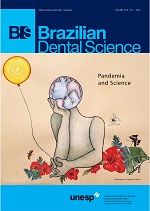Evaluation of Microleakage and Degree of Conversion of Three Composite Res-ins Polymerized at Different Power Densities
DOI:
https://doi.org/10.14295/bds.2020.v23i2.1948Abstract
Objectives: This study aims to evaluate the degree of conversion (DC) and microlekage scores of three different composite resins polymerized with a LED curing device in standard and extra-power mode. Material and Methods: One bulk-fill (Tetric EvoCeram Bulk-Fill – TECBF) and two conventional composite materials (Clearfil Majesty Posterior – CMP and Tetric EvoCeram – TEC) were evaluated. A total of 30 specimens were prepared for six groups (N = 5). These groups were polymerized with a LED curing device as follows: TECBF-6: 3200mW/cm2 for six seconds, TECBF-20: 1000mW/cm2 for 20 seconds, CMP-6: 3200mW/cm2 for six seconds, CMP-20: 1000mW/cm2 for 20 seconds, TEC-6: 3200mW/cm2 for six seconds, TEC - 20: 1000 mW/cm2 for 20 seconds. After 24 hours of water storage, DC was measured by Raman spectroscopy. Microleakage scores of the six groups were bonded to various adhesive systems (Clearfil SE Bond or Adhese Bond Universal) were also evaluated at Class II box cavities (N = 10). Results: While the highest DC was found at the top (TECBF-20= 79.92% and TECBF-6= 79.02%) and bottom surfaces (TECBF-20 = 68.94% and TECBF-6= 71.04%) for TECBF groups, TEC groups (TEC-20top = 59.06%, TEC-6top=49.66%, TEC-20bottom = 43.72% and TEC-6bottom= 40.68%) showed the lowest DC for the both surfaces (p < 0.05). Polymerization of materials in standard or extra-power mode was similar to DC (p > 0.05). Microleakage scores were found to be similar (p > 0.05). Conclusion: According to the results of the study, different power densities of LED curing light did not affect the DC of composite resins and microleakage values of restorations at small Class II cavities.
KEYWORDS
Bulk-fill composite; degree of conversion; LED curing device; microleakage; Raman spectroscopy.
Downloads
Downloads
Published
How to Cite
Issue
Section
License
Brazilian Dental Science uses the Creative Commons (CC-BY 4.0) license, thus preserving the integrity of articles in an open access environment. The journal allows the author to retain publishing rights without restrictions.
=================




























